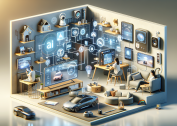Artificial intelligence is changing daily routines, from smart homes to healthcare. Explore practical ways AI is integrated into the technology around you, the effects on privacy, job automation, and what the future of smart technology might look like — all explained in simple terms with expert insights throughout.
How Artificial Intelligence Blends Into Ordinary Life
It’s remarkable how artificial intelligence, or AI, is already intertwined with daily experiences, sometimes in subtle but incredibly impactful ways. Every time you unlock a smartphone with facial recognition, use a digital assistant for reminders, or scroll through social media suggestions, AI is invisibly shaping those moments. These advanced systems analyze patterns, learn from user behavior, and offer personalized services to make interactions smoother and more engaging. The evolution of AI-driven features highlights not just convenience, but also a shift in how people relate to technology on a fundamental level.
Smart technology extends far beyond personal devices. Many homes now include thermostats that learn preferences, smart security cameras that distinguish between strangers and family, or refrigerators capable of auto-ordering groceries when supplies run low. These developments rely on neural networks and machine learning algorithms, which are two central AI techniques used for recognizing habits over time. With the proliferation of connected devices—and thanks to the Internet of Things (IoT)—artificial intelligence is quietly becoming the backbone of everyday comfort and safety, reshaping experiences across all ages.
AI-powered features reach other facets of life, such as helping drivers avoid traffic jams, optimizing power usage in smart grids, and supporting decision-making in public transport timing. Even spam filters in email, online banking fraud detection, and playlist recommendations are examples. It’s clear that artificial intelligence isn’t reserved for futuristic labs; it’s active in countless environments, quietly working in the background. This integration shows that technology is increasingly personalized and adaptive, promising efficiency and convenience—with careful oversight and continued research.
Smart Homes and Devices: The Rise of Everyday Automation
Smart homes demonstrate artificial intelligence in practical action. Voice-controlled speakers like Alexa and Google Home interpret natural language for everything from music requests to setting reminders. Learning thermostats reduce heating or cooling bills by adapting temperature preferences automatically. Similarly, connected lighting systems sense movement and natural light to optimize energy use. Each of these smart devices improves convenience and sustainability while reflecting advances in AI-powered automation. The notion of a connected, responsive environment is no longer science fiction but part of many modern households.
Intelligent appliances offer more than remote control. Washing machines monitor water quality and fabric type for optimal wash cycles, while robotic vacuums map entire living spaces to clean efficiently around obstacles. These devices use sensors and real-time data, a hallmark of modern artificial intelligence strategies. Integration with central apps or digital platforms allows for scheduling, monitoring, and even troubleshooting via the internet. This seamless connection creates opportunities for tailored experiences and energy resourcefulness—important themes as global sustainability concerns grow.
What drives increased interest in smart home technology? It’s the prospect of saving time and effort on routine tasks, as well as the safety benefits of continuous monitoring. Artificial intelligence enables predictive maintenance on appliances, alerts about unusual activity, and creates a sense of control even when occupants are away. Accessibility options improve as well, with AI enhancing the daily lives of older adults and individuals with mobility challenges. Exploring the capabilities of smart devices offers an intriguing look at how household routines continue to evolve.
Artificial Intelligence in Healthcare: A New Frontier
The impact of AI in healthcare quickly grows, introducing new possibilities for patient care, diagnostics, and research. Virtual assistants help schedule medical appointments and provide medication reminders. Wearable fitness trackers analyze health metrics and prompt users to stay active. In some hospitals, sophisticated artificial intelligence aids in reading X-rays or identifying symptoms in medical images, supporting professionals with rapid, data-driven insights. It’s a blend of man and machine striving for improved outcomes and early detection, with patient well-being always in focus.
Diagnostic accuracy improves due to AI’s ability to process vast medical data sets rapidly. Machine learning algorithms help flag abnormalities doctors might miss, enabling earlier interventions. Pharmaceutical research is also benefiting: AI models predict which compounds may be useful for new drugs, allowing for more targeted clinical trials. Of course, these advances come with strict ethical oversight and privacy protections, ensuring patient data is safeguarded while algorithms undergo continuous validation. The underlying goal is to enhance—not replace—human expertise.
Telemedicine platforms, powered by artificial intelligence, offer new ways to connect patients with care providers instantly. They assess symptoms, sort cases by urgency, and streamline administrative tasks—reducing wait times and improving efficiency. Many research institutions are exploring AI-driven support for chronic disease monitoring, mental health apps, and personalized treatment regimens. As these technologies mature, the healthcare experience is poised to become more proactive, empathetic, and data-enabled while responding to practical needs across the spectrum of life stages.
Privacy and Security: Navigating the Digital World with AI
As artificial intelligence becomes deeply embedded in technology, privacy and data security emerge as critical issues for users and policymakers alike. AI-driven personalization—whether recommendations or predictive search—often relies on extensive data collection. These datasets include browsing habits, purchasing preferences, and even real-time location data. While such information enables seamless, customized services, it raises valid concerns about misuse or unauthorized access. Regulatory frameworks continue adapting to balance innovation with user protection, an ongoing conversation in the digital age.
Many technology providers deploy robust encryption and security protocols to reduce risks. Artificial intelligence itself assists in detecting abnormal behavior—flagging suspicious account activity or automating fraud alerts in banking. Cybersecurity firms increasingly turn to self-learning systems to spot threats faster, adapting to new attack patterns in real time. However, experts emphasize that vigilance is necessary, with regular audits, transparent practices, and user education rounding out a comprehensive approach. Awareness of these digital safeguards allows consumers to better evaluate the convenience-security trade-off.
Legislation like the General Data Protection Regulation (GDPR) and various privacy acts aim to empower users with control over their personal information. Artificial intelligence plays a dual role: powering sophisticated services while also enabling data minimization and anonymization techniques. This careful balance is crucial as governments, businesses, and consumers seek clarity and trust in an ecosystem that is interconnected and data-driven. Ongoing dialogue between researchers, industry, and society remains vital for progress.
Jobs, Automation, and the Changing World of Work
Artificial intelligence is reshaping the employment landscape. Industries such as manufacturing, logistics, and customer service increasingly rely on AI-powered robots and digital assistants to automate routine work. While this improves productivity and reduces operational costs, it naturally leads to concerns about job displacement. On the other hand, new opportunities can emerge in areas such as AI system development, data analytics, and technology maintenance. The workforce is evolving, highlighting the need for continuous skill development and adaptability.
Upskilling is a central theme in responding to automation. Various educational resources—including online platforms, coding bootcamps, and university programs—help workers transition to data science, artificial intelligence, or cybersecurity roles. Governments and organizations promote lifelong learning initiatives to support these shifts, aiming to bridge the digital skills gap. Efforts focus on developing both technical expertise and soft skills, such as critical thinking and problem solving, which complement automated tasks.
Ultimately, technology’s influence on employment is nuanced. While some positions are automated, others become safer or more productive, and entirely new careers are created. Artificial intelligence serves as a catalyst for reimagining whole industries, from healthcare to creative sectors. Preparing for the future means acknowledging ongoing changes and exploring opportunities for meaningful contributions within a transforming job market.
The Road Ahead: AI’s Promise and the Questions It Raises
AI’s rapid advancement invites both excitement and careful reflection. On one hand, its capacity to process information and generate insights is transforming research, education, and entertainment. Projects in natural language processing create more intuitive interfaces, while breakthroughs in robotics suggest greater independence and assistance for an aging population. The opportunities seem limitless. Yet, fundamental questions of fairness, transparency, and ethical boundaries remain part of the dialogue.
International organizations and research institutions promote ethical guidelines for the responsible development of artificial intelligence. These principles emphasize transparency, accountability, and the avoidance of bias—essential for public confidence in AI-powered systems. Collaboration across disciplines and cultures enriches this field, ensuring a broad spectrum of perspectives. The momentum behind “explainable AI” aims to provide clarity about how automated decisions are reached, spotlighting the need for systems that are not only powerful, but also trustworthy.
For individuals, families, businesses, and governments, the most effective way to shape the future of artificial intelligence is by remaining curious, adaptable, and well-informed. The path ahead calls for ongoing exploration—of how society wants to live with and benefit from AI. As new innovations unfold, staying engaged with education and public discussion will ensure that artificial intelligence delivers on its promise to support well-being, creativity, and mutual progress.
References
1. European Commission. (n.d.). Artificial Intelligence. Retrieved from https://digital-strategy.ec.europa.eu/en/policies/artificial-intelligence
2. National Institute of Standards and Technology. (2023). Artificial Intelligence Overview. Retrieved from https://www.nist.gov/artificial-intelligence
3. Mayo Clinic. (n.d.). Artificial Intelligence in Health Care. Retrieved from https://www.mayoclinic.org/medical-professionals/clinical-updates/general-medical/artificial-intelligence-in-health-care
4. World Economic Forum. (2022). The Impact of Artificial Intelligence on Work. Retrieved from https://www.weforum.org/agenda/2022/10/ai-job-workforce-innovation/
5. Office of the Australian Information Commissioner. (n.d.). Artificial intelligence, privacy and data protection. Retrieved from https://www.oaic.gov.au/privacy/privacy-guidance-for-organisations/artificial-intelligence-privacy-and-data-protection
6. United Nations Educational, Scientific and Cultural Organization. (2022). Ethics of Artificial Intelligence. Retrieved from https://en.unesco.org/artificial-intelligence/ethics









